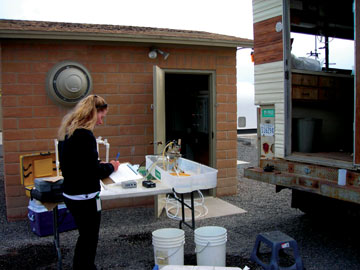|
NEWS NOTES
Science and Society
Nevada wells test positive for polonium
 Courtesy of Ralph Seiler |
| U.S. Geological Survey hydrologist Jena Green tests the water at a municipal well in Churchill County, Nev., an area where researchers have found high polonium-210 concentrations in the groundwater. |
On Aug. 3, 2007, the U.S. Geological Survey (USGS) reported to well owners that 25 wells in Lahontan Valley in Churchill County, Nev., contained the carcinogenic, radioactive isotope polonium-210. Of these wells, 13 exceeded the U.S. Environmental Protection Agency’s (EPA) Maximum Contaminant Level for “gross alpha radioactivity” in a public water supply. The average polonium-210 concentrations in the wells exceeded typical groundwater concentrations. Just how that polonium got into the water is debatable.
USGS researchers say that there is no evidence that the polonium-210 came from human activity, such as the nuclear testing that occurred in Nevada during the 20th century. Instead, they think that the polonium-210 in the well water is a natural product of the radioactive decay of uranium in the aquifer matrix. Researchers suspect that the uranium, which does not occur naturally in the rocks in Churchill County, was likely carried into the valley by streams that eroded uranium-bearing granites in the Sierra Nevada during the Pleistocene about 1.8 million to 11,000 years ago, according to Ralph Seiler, a USGS hydrologist in Reno, Nev., who led the study of the well water. That uranium now sits in the aquifer, decaying into polonium-210 before entering the water supply. The mystery, Seiler says, is why polonium-210 is so high in Churchill County in particular, when granitic rocks and uranium are generally prevalent across the region.
The new analysis by Seiler and colleagues follows up on a 2001 study, in which USGS researchers sampled 100 Churchill County wells as part of an investigation of a cancer cluster. Between 1997 and 2002, 16 children in Churchill County were diagnosed with acute leukemia. Out of a total county population of about 24,000, this is an anomalous incidence rate, 20 times the national average. The cause of the sudden outbreak remains unknown, but hypotheses range from the high polonium concentrations in the water to genetic variation in the patients to environmental toxins caused by jet fuel spills, pesticides and a local tungsten refinery. Researchers are currently investigating both environmental and genetic factors that might have contributed to the leukemia cluster.
Chris Pritsos, a biochemist at the University of Nevada at Reno, is studying the physiological effects of ingesting the well water in Churchill County. At this point in time, he says that he does not know whether the water contributed to the leukemia cluster that began in the late 1990s. Pritsos is looking at oxidative stress and immune function in mice whose drinking water comes from the Churchill County wells, and notes that in addition to polonium-210, the water is also high in arsenic and tungsten, which can both be toxic. He also says that the connection between ingested polonium-210 and leukemia may be less pronounced than, for example, the connection between lung cancer and polonium-210 inhaled from cigarette smoke, because the inhaled radiation is deposited directly to the lung tissue, whereas radiation ingested from drinking water passes through the liver and spleen before it reaches the bone marrow.
The current study found the median concentration of polonium-210 in the 25 wells in Churchill County to be 18 picocuries per liter, with a maximum of 67.7 picocuries per liter and a minimum of less than 0.1 picocuries per liter, making the median polonium-210 concentration in a liter of the well water roughly five to six times greater than the amount in a pack of cigarettes, but hundreds of millions of times less than the amount that poisoned and killed Russian spy Alexander Litvinenko in November 2006. Though EPA has not set a drinking water standard specifically for polonium, the level of polonium-210 in most of the sampled wells pushed them over EPA’s Maximum Contaminant Level for gross alpha radioactivity, which is 15 picocuries per liter. Of the 25 wells tested in Churchill County, researchers only found high polonium-210 concentrations in private wells, Seiler says. The city of Fallon and Churchill County sampled their own municipal wells and found them to be safe.
Finding concentrations of polonium-210 greater than 10 picocuries per liter is rare, Seiler says, and has occurred only in a few wells in the United States, including 30 to 40 wells east of Tampa, Fla., a single well in Alexandria, La., a well in an undisclosed location in California and the Churchill County wells. What all the wells have in common, Seiler says, is contact with uranium sources and, in the Florida and Nevada wells, waters with low oxygen levels. The Florida wells are characterized by dilute acidic waters, while the Nevada wells are more saline and alkaline. These areas also appear to have sulfate-reducing bacteria. But the story doesn’t end there, he says. “We need to do more research” to further identify what the areas have in common, he adds, “so we can predict where polonium-210 will be a problem.”

 Subscribe
Subscribe


